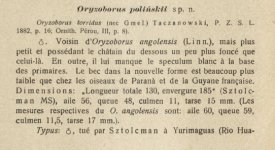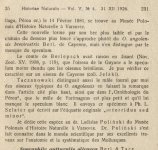Björn Bergenholtz
(former alias "Calalp")

Succé, gaura … and Mr. Poliński
Here´s two other of James's "unseen" ones … and a possible amendment:
● succe
… in the invalid "A. [Anas] Succé" a k a "Le Canard succé" BONNATERRE 1791 (here), based on von Jacquin's Beyträge zur Geschichte der Vögel, p. 5 and its "Succé") (here) [syn. Dendrocygna arborea LINNAEUS 1758].
Also noted in the HBWAlive Key entry for jacquini/jacquinii (here).
● gaura
… in the invalid "Emberiza gaura" FORSTER 1795 (in Latham and Davies's Faunula Indica 1795), here (page 9), based on Latham's Supplement to the General Synopsis of Birds 1787 (here) [syn. … of what?].
However; enjoy!
And Good luck solving them.
Björn
PS. A minor observation, possibly a simple typo; When flipping through the 1927 issue of Prace Zoologiczne Polskiego Państwowego Muzeum Przyrodniczego / Annales Zoologici Musei Polonici Historiae Naturalis 6 looking for the OD of "Dryobates minor lönnbergi" (found it!) I happened to notice a bird by the name "polińskii".
● polinskii
This name (or spelling) is not listed in today's HBWAlive Key, but instead as: "polinksii".
The original spelling, as far as I can tell (without having seen the OD!), was according to Sztolcman himself (& Domaniewski, in the above mentioned journal of 1927), described as: "Oryzoborus polińskii" SZTOLCMAN 1926. See attached jpg. [syn. (Sporophila) Oryzoborus angolensis LINNAEUS 1766]
= most likely the Polish zoologist and malacologist Władysław Karol Poliński (1885–1930) … or?
/B
---
Here´s two other of James's "unseen" ones … and a possible amendment:
● succe
… in the invalid "A. [Anas] Succé" a k a "Le Canard succé" BONNATERRE 1791 (here), based on von Jacquin's Beyträge zur Geschichte der Vögel, p. 5 and its "Succé") (here) [syn. Dendrocygna arborea LINNAEUS 1758].
Also noted in the HBWAlive Key entry for jacquini/jacquinii (here).
● gaura
… in the invalid "Emberiza gaura" FORSTER 1795 (in Latham and Davies's Faunula Indica 1795), here (page 9), based on Latham's Supplement to the General Synopsis of Birds 1787 (here) [syn. … of what?].
However; enjoy!
And Good luck solving them.
Björn
PS. A minor observation, possibly a simple typo; When flipping through the 1927 issue of Prace Zoologiczne Polskiego Państwowego Muzeum Przyrodniczego / Annales Zoologici Musei Polonici Historiae Naturalis 6 looking for the OD of "Dryobates minor lönnbergi" (found it!) I happened to notice a bird by the name "polińskii".
● polinskii
This name (or spelling) is not listed in today's HBWAlive Key, but instead as: "polinksii".
The original spelling, as far as I can tell (without having seen the OD!), was according to Sztolcman himself (& Domaniewski, in the above mentioned journal of 1927), described as: "Oryzoborus polińskii" SZTOLCMAN 1926. See attached jpg. [syn. (Sporophila) Oryzoborus angolensis LINNAEUS 1766]
= most likely the Polish zoologist and malacologist Władysław Karol Poliński (1885–1930) … or?
/B
---
Attachments
Last edited:







